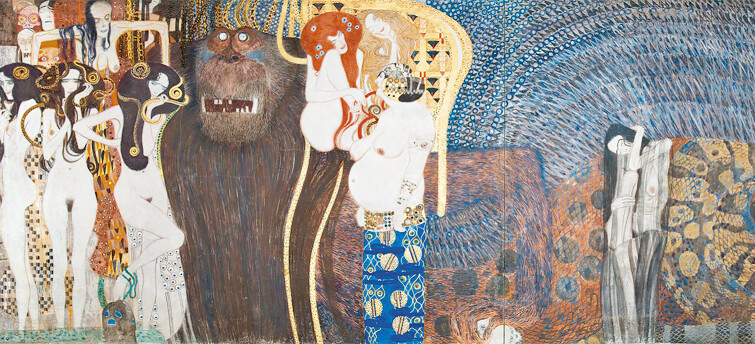Food for the Soul: Loving Beethoven


Gustav Klimt. Beethoven Frieze (detail). Vienna. Photo: Public Domain Wikimedia Commons
By Nina Heyn – Your Culture Scout
Ludwig van Beethoven’s birth date is unknown but his baptism, that most likely took place no later than a day later, has been recorded as December 17, 1770. This year, therefore, it is a round 250 year anniversary of the composer’s birth.
To celebrate, we have made a podcast about some of Beethoven’s famous works and our concert stories. You can find it right here, on this site.
Beethoven needs no introduction to anyone even tangentially familiar with classical music and his most famous and beloved pieces are usually the same favorites for listeners all over the world – his nine symphonies, his five piano concertos, some of the most often played sonatas like the Moonlight or Pathétique, his only violin concerto. For many people, like me, the favorite pieces would also include the Apassionata or the Waldstein sonata, Triple Concerto op. 56 or Missa Solemnis.
Nürmberg. Flash mob performance of Beethoven’s “Ode to Joy.” 2014
Attending actual philharmonic concerts of Beethoven is not that easy. Even in normal times tickets are hard to get and expensive. In the year of the virus live concerts with audiences have not been taking place for months and no one knows when they will return to concert halls or when will the audiences return. We are reduced to listening to recorded music, and luckily there is no lack of great recordings of Beethoven pieces. There are also videos…Thanks to internet, cell phones and young musicians familiar with social media, there is a 21st century phenomenon of flash mob performances. Some of them have been of Beethoven’s music. Even if those performances are ephemeral and truncated (only a fragment of the 9th Symphony), they show how his music affect people, sometimes even unprepared passers-by.
Banco Sabadell, Spain. Flash mob performance of Beethoven’s “Ode to Joy.” 2012.
This is a flash mob performance of a few minutes of Beethoven’s 9th symphony (the whole work’s duration is over an hour) to a crowd of passers-by at a city square in Spain. Since 2012 this video itself has garnered 86 million views. Another video of a flash mob performance, in Nuremberg (see above) has had 25 million views and hundreds of grateful comments from all over the world. “Ode of Joy” written by elderly Beethoven in 1824 for the fourth movement of his last symphony, has been set to Friedrich Schiller’s enthusiastic poem about friendship of brotherhood of mankind and clearly it still resonates the same way as hundreds of years ago.
Here is another flash mob gathering for a performance by Wayzata Symphony Orchestra and Edina Chorale in Minneapolis in 2015. The joy of watching these videos is not only in the music itself (after all it is just a teaser of this movement with no soloists) but also in the reactions of random mall visitors who are totally unprepared for either a performance stunt or classical music. And yet they applaud enthusiastically at the end.
My favorite video is that of the symphony’s entire fourth movement, professionally performed in Osaka, Japan, with an orchestra, and Yutaka Sado as conductor in 2012. In Japan performing the 9th is a holiday tradition since WWII. The catch is that this traditional New Year’s performance is sung here by a choir of 10,000 singers, perfectly coordinated and staged.
This one has been bringing tears to viewers for years, not only thanks to music but also to the effort of these 10,000 singers who have been rehearsing for months for this one moment of joy of music.
I will leave you with a video to the entire Emperor’s concerto performed by the Polish artist Kristian Zimmerman and the Berlin Philharmonic Orchestra conducted by Leonard Bernstein. Bernstein planned but not lived long enough to complete recordings of all five concertos so this performance is part of his legacy.
